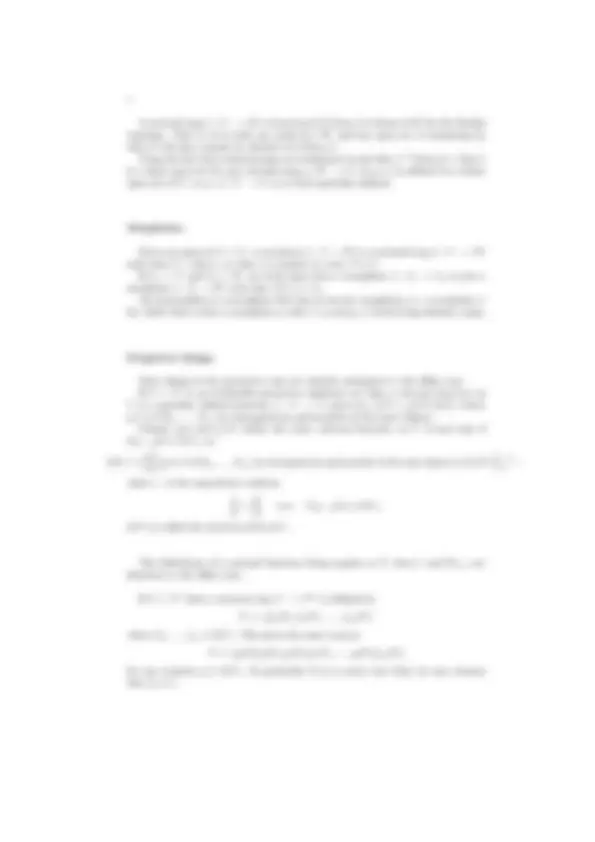





Study with the several resources on Docsity

Earn points by helping other students or get them with a premium plan


Prepare for your exams
Study with the several resources on Docsity

Earn points to download
Earn points by helping other students or get them with a premium plan
Community
Ask the community for help and clear up your study doubts
Discover the best universities in your country according to Docsity users
Free resources
Download our free guides on studying techniques, anxiety management strategies, and thesis advice from Docsity tutors
The third lecture notes in algebraic geometry, focusing on zariski topology and functions on varieties. It covers the definition of a topology, zariski topology on affine and projective spaces, polynomial functions and maps, rational functions, and morphisms. It also explains the concept of dominant rational maps and birational maps.
Typology: Study notes
1 / 5

This page cannot be seen from the preview
Don't miss anything!




Algebraic Geometry: Lecture 3
Zariski Topology.
Given a set X, a topology on X is just a list T of subsets of X that satisfy the following properties:
(1) ∅ ∈ T , X ∈ T
(2) If A 1 , A 2 ,... ∈ T then
i Ai^ ∈^ T
(3) If A, B ∈ T then A ∩ B ∈ T. The subsets of X that belong to T are called the open sets of X.
If A ⊂ X is an open set then X \ A is called a closed set. So we can just as easily define a topology on a set X by listing all the closed sets, and then taking the open sets to be all their complements.
As last week, assume k is an algebraically closed field. Recall that for a subset S ⊂ k[X 1 ,... , Xn],
V (S) = {P ∈ An^ | f (P ) = 0 for all f ∈ S},
and these sets are called the affine algebraic sets.
The Zariski topology is just a topology on An^ where the closed sets are precisely the algebraic sets in An. It’s an easy exercise to see this is a topology using the facts that:
(1) ∅ = V (k[X 1 ,... , Xn]), An^ = V (0),
(2) V (S 1 ) ∪ V (S 2 ) = V (S 1 S 2 ),
(3)
i V^ (Si) =^ V^ (
i Si)^.
The Zariski topology isn’t very subtle. Closed sets are mostly very small, for example if k = C then a typical closed set is just a finite set of points, hence a typical open set is all of C except a finite number of points.
The Zariski topology on Pn^ is defined exactly the same way, with projective algebraic sets forming the closed sets. Other than the fact you’re now dealing with homogeneous polynomials, everything is the same. Using this topology we define a quasi-affine variety to be an open subset of an affine variety, and a quasi-projective variety to be an open subset of a projective variety.
1
Functions on Varieties
Polynomial functions.
Let V ⊂ An^ be an algebraic set and I(V ) the corresponding ideal. (Recall, I(V ) is the ideal of polynomials that vanish at all points of V .) We define a polynomial function on V to be a map f : V → k of the form P 7 → F (P ) where F ∈ k[X 1 ,... , Xn]. So f is the restriction of a polynomial F : An^ → k. By definition of I(V ), two polynomials F, G ∈ k[X 1 ,... , Xn] define the same function on V if and only if F (P ) − G(P ) = 0 for all P ∈ V , i.e. if and only if F − G ∈ I(V ). So we define the coordinate ring k[V ] by
k[V ] = {f : V → k | f is a polynomial function } ∼= k[X 1 ,... , Xn]
Polynomials maps.
A generalisation of the above idea is as follows. Let V ⊂ An^ and W ⊂ Am^ be algebraic sets. A map f : V → W is a polynomial map if there exist m polynomials F 1 ,... , Fm ∈ k[X 1 ,... , Xn] such that
f (P ) = (F 1 (P ),... , Fm(P )) ∈ W for all P ∈ V.
In particular a polynomial function is just a polynomial map with m = 1.
Examples
(1) Simple parameterisations like C → C^2 , t 7 → (t^2 , t^3 ) (a cuspidal cubic), or t 7 → (t^2 − 1 , t^3 − 1) (nodal cubic) are polynomial maps.
(2) We can also take projections, for example π : C^3 → C^2 , (x, y, z) 7 → (x, y).
A polynomial map f : V → W between algebraic sets is called an isomorphism if there exists a polynomial map g : W → V such that f ◦ g = idW and g ◦ f = idV. An affine variety is an irreducible algebraic subset V ⊂ An, defined up to iso- morphism. If V is an affine variety then we saw last week that I(V ) is a prime ideal, which means k[V ] = k[X 1 ,... , Xn]/I(V ) is an integral domain. So we can define... The function field k(V ) of V is the field of fractions
k(V ) = Frac (k[V ]) =
{ (^) g h
∣ g, h^ ∈^ k[V^ ], h^6 = 0
An element f ∈ k(V ) is called a rational function on V. f is not really a function on V because its denominator will probably have zeroes. But away from these places it is a function, which motivates... Let f ∈ k(V ) and P ∈ V. We say f is regular at P if there exist an expression f = g/h with g, h ∈ k[V ] and h(P ) 6 = 0. If f is regular at all points of V then we simply say it is regular.
A rational map f : V 99K W is dominant if f (dom f ) is dense in W for the Zariski topology. That is, if we pick any point Q ∈ W and any open set S containing Q, then S will also contain an element of f (dom f ). Using the fact that rational maps are continuous we get that f −^1 (dom g) ⊂ dom f is a dense open set for any rational map g : W 99K U , so g ◦ f is defined on a dense open set of V , so g ◦ f : V 99K U is at least partially defined.
Morphisms.
Given an open set U ⊂ V , a morphism f : U → W is a rational map f : V 99K W such that U ⊂ dom f , so that f is regular at every P ∈ U. If U 1 ⊂ V and U 2 ⊂ W are both open then a morphism f : U 1 → U 2 is just a morphism f : U 1 → W such that f (U 1 ) ⊂ U 2. An isomorphism is a morphism that has an inverse morphism, i.e. a morphism f for which there exists a morphism g with f ◦ g and g ◦ f both being identity maps.
Projective things.
Most things in the projective case are entirely analogous to the affine case. If V ⊂ Pn^ is an irreducible projective algebraic set then a rational function on V is a partially defined function f : V 99K k given by f (P ) = g(P )/h(P ) where g, h ∈ k[X 0 ,... , Xn] are homogeneous polynomials of the same degree. Clearly g/h and g′/h′^ define the same rational function on V if and only if h′g − g′h ∈ I(V ), so
k(V ) =
{ (^) g h
∣ g, h^ ∈^ k[X 0 ,... , Xn]^ are homogeneous polynomials of the same degree, h^6 ∈^ I(V^ )
where ∼ is the equivalence relation g h
g′ h′^
⇐⇒ h′g − g′h ∈ I(V ).
k(V ) is called the function field of V.
The definitions of a rational function being regular at P , dom f , and OV,P are identical to the affine case.
If V ⊂ Pn^ then a rational map V 99K Pm^ is defined by P 7 → [f 0 (P ), f 1 (P ),... , fm(P )] where f 0 ,... , fm ∈ k(V ). This gives the same map as P 7 → [g(P )f 0 (P ), g(P )f 1 (P ),... , g(P )fm(P )] for any nonzero g ∈ k(V ). In particular if f 0 is never zero then we may assume that f 0 ≡ 1.
A rational map f : V 99K Pm^ is regular at P ∈ V if there exists an expression f = (f 0 ,... , fm) such that
(1) f 0 ,... , fm are all regular at P ,
(2) at least one fi(P ) 6 = 0.
Again, if U ⊂ V is an open subset of a projective variety V then a morphism f : U → W is a rational map f : V → W with U ⊂ dom f.
Birational maps.
Let V and W be (affine or projective) varieties. A rational map f : V 99K W is called birational if it has a rational inverse, i.e. if there is a rational map g : W 99K V such that f ◦ g = idW and g ◦ f = idV.